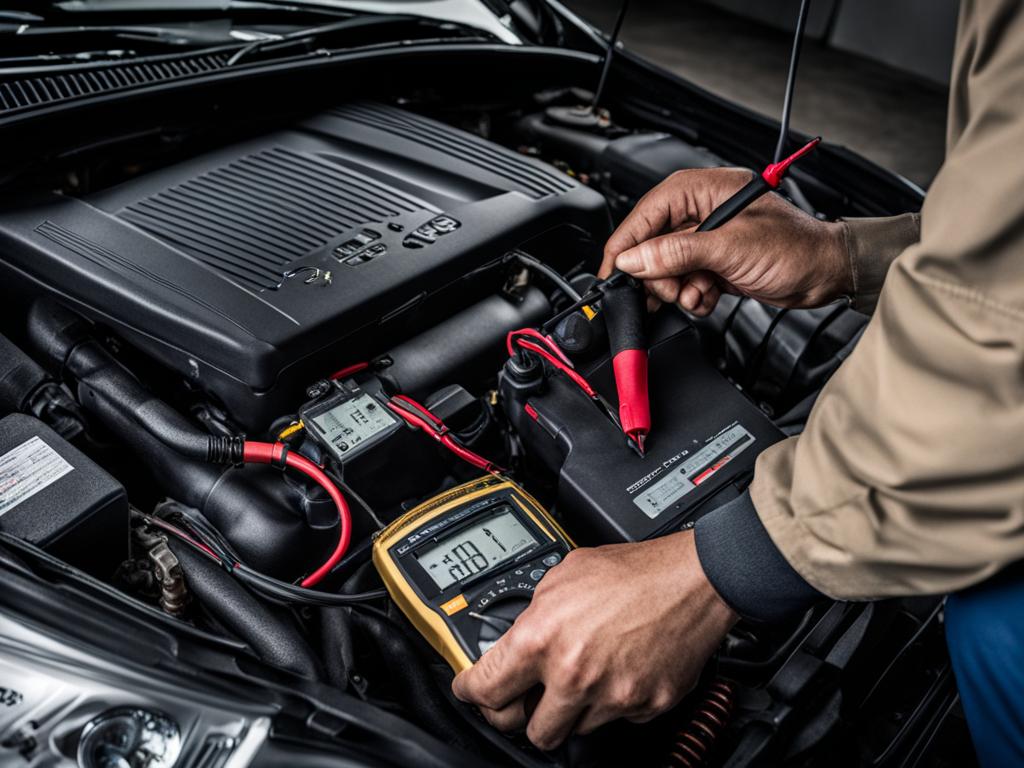Lexus Won’t Start But Has Power? Troubleshoot Now!
If you’re experiencing the frustrating issue of your Lexus not starting despite having power, there are several potential causes that could be at play. It’s essential to troubleshoot and identify the root problem to get your vehicle back on the road.
In this article, we will explore common reasons why your Lexus engine has power but won’t start and provide solutions to help you troubleshoot the issue. Whether it’s a battery problem, an anti-deterrent ECU malfunction, a faulty starter relay, issues with the neutral start, or a problem with the starter circuit, we’ve got you covered.
With our step-by-step guidance, you’ll be able to diagnose and potentially resolve the problem, ensuring a smooth and reliable starting experience for your Lexus.
Key Takeaways:
- When your Lexus won’t start but has power, check the battery and associated cables for any issues.
- A faulty Anti-Deterrent ECU could be causing the starting problem; resetting it may help resolve the issue.
- If you hear a clicking sound while starting your Lexus, the starter relay might be faulty.
- Inspect the transmission shifter if there are no park or neutral indicator lights or if there’s no turning or clicking sound when turning the key.
- Bypassing the starter circuit can help determine if the starter is the problem.
Possible Battery and Cable Issues
If your Lexus has power but fails to start, one possible cause could be a weak battery. However, if all the lights and fans are functioning properly, the battery is unlikely to be the issue. Charging the battery or checking the battery and associated cables can help determine if this is the problem.
When your Lexus won’t start but has power, it can be frustrating and leave you wondering what the problem could be. One common culprit is a weak battery. Although you may have enough power to operate the lights and accessories, the battery might not have enough juice to crank the engine and start the car.
If your Lexus won’t start but has power:
- Check the battery voltage using a multimeter. A healthy battery should have a voltage reading between 12.4 and 12.7 volts. If the reading is below this range, it indicates a weak battery.
- If the battery voltage is low, try jump-starting the car using another vehicle or a portable jump starter. This can provide the necessary power to start the engine.
- If jump-starting the car works, the issue may be with the battery itself. Consider replacing it to ensure reliable starting in the future.
- Inspect the battery cables and connections for any signs of corrosion or damage. Clean the battery terminals and cable ends if necessary, ensuring a good connection.
- If the battery and cables are in good condition, but the car still won’t start, it’s advisable to seek professional assistance to diagnose and resolve the issue.
It’s worth noting that even a seemingly charged battery can fail to deliver enough power if there is a problem with the internal cells. Testing the battery’s cold cranking amps (CCA) can provide a more accurate assessment of its condition. If the CCA is significantly lower than the battery’s rating, it may need replacement.
Remember, always prioritize your safety when working with car batteries. Follow correct procedures and precautions to avoid any accidents or injuries.
Anti-Deterrent ECU Malfunction
If your Lexus won’t start despite having power, another possible culprit could be a faulty Anti-Deterrent ECU (Electronic Control Unit). The Anti-Deterrent ECU is responsible for preventing unauthorized use of the vehicle by disabling the engine start function.
If you have recently shared your car with someone or encountered an issue with the key, it could trigger an Anti-Deterrent ECU malfunction. In such cases, the ECU may prevent the engine from starting even though there is electrical power available.
To resolve this issue, you can try resetting the Anti-Deterrent ECU using a simple procedure. Here are the steps to follow:
- Insert the key into the ignition and turn it to the “On” position.
- Within five seconds, turn the key back to the “Off” position.
- Repeat the above two steps two more times, ending in the “Off” position.
- Remove the key from the ignition and wait for at least 10 seconds.
- Insert the key back into the ignition and start the engine as usual.
Resetting the Anti-Deterrent ECU can help reestablish proper communication and functionality, allowing your Lexus to start normally.

| Common Symptoms of Anti-Deterrent ECU Malfunction | Potential Solutions |
|---|---|
| The engine cranks but does not start. | Reset the Anti-Deterrent ECU using the procedure mentioned above. |
| The engine does not respond when the key is turned. | Check if the key is functioning properly or try using a spare key. |
| The immobilizer light remains illuminated or flashes. | Contact a professional technician or Lexus dealership for further assistance. |
If the Anti-Deterrent ECU reset does not resolve the issue, it is recommended to consult a qualified mechanic or bring your vehicle to a Lexus dealership for a more in-depth diagnosis and repair.
Faulty Starter Relay
If you hear a clicking sound when trying to start your Lexus, it might indicate a faulty starter relay.
To determine if the relay is the problem, you can open the engine bay fuse box and listen for the click sound. Alternatively, testing the relay by replacing it with a working one can help confirm if the starter relay is at fault.
How to Test the Starter Relay
Follow these steps to test the starter relay:
- Locate the fuse box in the engine bay.
- Identify the starter relay. Refer to the vehicle’s owner manual or the fuse box diagram for guidance.
- Carefully remove the faulty starter relay from its socket.
- Replace the faulty relay with a known working one of the same type and specifications.
- Attempt to start the Lexus.
- If the Lexus starts without any issues, it confirms that the faulty starter relay was causing the problem.
- If the Lexus still won’t start or exhibits the same clicking sound, the issue may lie elsewhere in the electrical system.
If the starter relay is indeed defective, a replacement relay can be purchased from an authorized Lexus dealership or auto parts store.
Note: It’s important to consult the vehicle’s manual or have a professional mechanic guide you through the diagnostic and repair process for accurate and safe troubleshooting.
Comparison of Symptoms and Solutions
| Symptom | Possible Cause | Solution |
|---|---|---|
| Clicking sound when attempting to start | Faulty starter relay | Replace starter relay |
| No sound or action when turning the key | Dead battery or faulty ignition switch | Charge or replace battery, or replace ignition switch |
| Engine cranks but won’t start | Fuel system or ignition system issues | Check fuel pump, spark plugs, and ignition coil |
| Engine starts but immediately stalls | Fuel system or electronic throttle control issues | Clean or replace fuel injectors, check throttle body |
Issues with Neutral Start
Over time, the transmission shifter linkage in older cars can cause starting issues. If you notice a lack of park (P) or neutral (N) indicator lights or no turning or clicking sound when turning the key, the problem might lie with the transmission shifter. Pushing forward on the shifter or holding the key in the on position while pushing the shifter can help establish contact and resolve the issue.
It is important to check the condition of the shifter and ensure it is functioning properly. If the shifter is worn or damaged, it may not be able to engage the necessary components to start the engine. Additionally, debris or a buildup of dirt and grime in the shifter mechanism can also cause issues with starting the vehicle.
“A faulty transmission shifter can prevent the engine from starting even if there is power. It is crucial to address this issue promptly to avoid further complications.”
Inspecting the shifter and cleaning any debris can sometimes solve the problem. However, if the shifter is severely damaged or worn, it may need to be replaced. It is recommended to consult a professional mechanic or refer to the vehicle’s manual for guidance on inspecting and repairing the transmission shifter.
This issue is particularly common in older Lexus models, such as the Lexus ES, RX, or LS, where the shifter linkage may become less responsive over time.
Example Lexus Models with Neutral Start Issues:
| Lexus Model | Year |
|---|---|
| Lexus ES | 2003 |
| Lexus RX | 2007 |
| Lexus LS | 2010 |
By addressing issues with the transmission shifter, you can ensure a smoother and more reliable starting experience for your Lexus.

Bypassing the Starter Circuit
If all else fails, bypassing the starter circuit can help you determine if the starter itself is the problem. By supplying power directly to the starter using a specific procedure, you can bypass the electronic circuitry and test the starter. If the starter turns when bypassing, it indicates a faulty circuitry issue, while a lack of response suggests a faulty starter that needs replacement.
To bypass the starter circuit, follow these steps:
- Make sure the vehicle is in park or neutral with the parking brake engaged and the ignition key turned off.
- Locate the starter motor under the hood of your Lexus.
- Identify the starter solenoid, typically attached to the side of the starter motor.
- Disconnect the electrical connections from the starter solenoid.
- Attach a jumper wire or metal object to the battery positive terminal.
- Touch the other end of the jumper wire to the terminal on the starter solenoid that was previously connected to the battery positive terminal.
- If the starter motor engages and turns the engine, it indicates a faulty circuitry issue.
If the starter motor does not engage or turn the engine, it suggests a faulty starter that needs to be replaced.

By bypassing the starter circuit, you can effectively isolate the issue and determine if it lies with the starter or the electrical circuitry. This procedure can help you make an informed decision regarding the necessary repairs. However, it is important to note that bypassing the starter circuit should only be done by experienced individuals or under the guidance of a professional mechanic to avoid any potential risks or damage to your vehicle.
Conclusion
Troubleshooting a Lexus that won’t start but has power can be a frustrating experience. However, by following a systematic approach and checking various potential issues, you can identify and resolve the underlying problem.
Start by inspecting the battery and associated cables. A weak battery or loose connections can prevent the car from starting. If these components are in good condition, consider resetting the Anti-Deterrent ECU. Sometimes, issues with the ECU can interfere with the starting process, and a simple reset can fix the problem.
If the issue persists, test the starter relay, which is responsible for engaging the starter motor. A faulty relay can prevent the car from starting, even if it has power. Additionally, inspect the transmission shifter for any issues. Over time, the shifter linkage can cause starting problems, so ensure it’s functioning properly.
If all else fails, try bypassing the starter circuit to determine if the starter itself is the culprit. By supplying power directly to the starter, you can assess its functionality. If the starter turns but the car still won’t start, there may be a problem with the circuitry. However, if there is no response from the starter, it may need to be replaced.
If you’ve exhausted the troubleshooting methods mentioned above and are still unable to resolve the issue, it’s best to seek assistance from a professional mechanic or bring your Lexus to a dealership for further diagnosis and repair. They have the expertise and specialized tools to identify and address complex starting problems.
FAQ
What could be causing my Lexus to not start despite having power?
There are several potential issues that could cause your Lexus to not start despite having power. Some common causes include a weak battery, a faulty Anti-Deterrent ECU, a faulty starter relay, issues with the neutral start, or a faulty starter.
How can I determine if a weak battery is causing my Lexus not to start?
If all the lights and fans are functioning properly, the battery is unlikely to be the issue. However, you can charge the battery or check the battery and associated cables to ensure they are in good working condition.
How can I reset the Anti-Deterrent ECU in my Lexus?
If you have recently shared your car with someone and suspect that the Anti-Deterrent ECU is causing the issue, you can reset it using the key. The specific procedure to reset the Anti-Deterrent ECU may vary, so consult your vehicle’s manual for instructions.
How can I test if the starter relay is faulty in my Lexus?
To determine if the starter relay is the problem, you can open the engine bay fuse box and listen for a clicking sound when trying to start your Lexus. Alternatively, you can test the relay by replacing it with a known working one.
What should I do if there are issues with the neutral start in my Lexus?
If you notice a lack of park (P) or neutral (N) indicator lights or no turning or clicking sound when turning the key, the problem might be related to the transmission shifter. You can try pushing forward on the shifter or holding the key in the on position while pushing the shifter to establish contact and resolve the issue.
How can I bypass the starter circuit to test if the starter is faulty in my Lexus?
If all else fails, you can bypass the starter circuit by supplying power directly to the starter using a specific procedure. If the starter turns when bypassing, it indicates a faulty circuitry issue. If there is no response from the starter, it suggests a faulty starter that needs replacement.
What should I do if none of these troubleshooting methods resolve the issue?
If the troubleshooting methods mentioned above do not solve the problem, it is recommended to consult a professional mechanic or bring your vehicle to a Lexus dealership for further diagnosis and repair.




